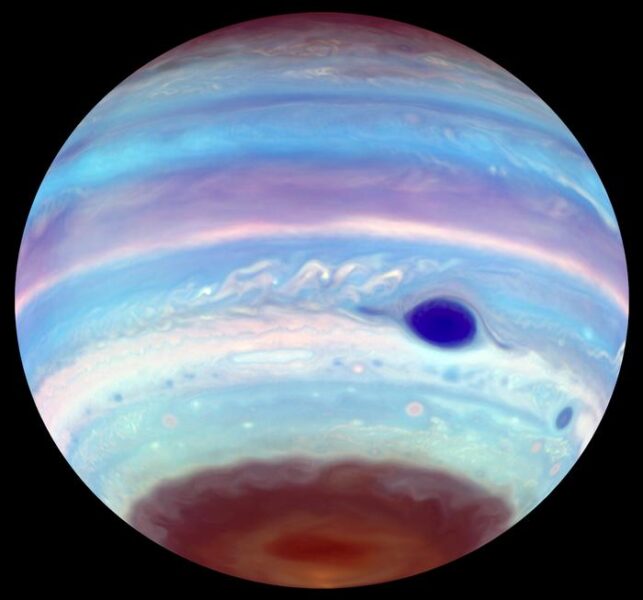While Jupiter’s Great Red Spot has long captivated observers, scientists have uncovered another fascinating phenomenon at the gas giant’s poles: Earth-sized dark spots that appear and vanish in the planet’s polar haze, stirred into existence by massive magnetic vortices that act like cosmic tornadoes.
Published in Nature Astronomy | Estimated reading time: 4 minutes
These mysterious dark ovals, visible only in ultraviolet light, emerge beneath Jupiter’s auroral zones where they absorb UV radiation more strongly than their surroundings. Through systematic analysis of Hubble Space Telescope observations spanning nearly three decades, researchers have revealed that these features appear with surprising regularity—showing up 75% of the time at the south pole, while making only rare appearances in the north.
“In the first two months, we realized these OPAL images were like a gold mine,” says Troy Tsubota, a UC Berkeley senior who led the systematic study of the phenomenon. His analysis uncovered eight southern UV-dark ovals between 1994 and 2022, while only two northern ovals appeared during the same period.
The mechanism behind these dark spots appears to be a complex interplay between Jupiter’s powerful magnetic field and its atmosphere. According to Tom Stallard at Northumbria University, the spots likely form when magnetic field lines create friction between two distant regions: the planet’s ionosphere and the plasma sheet created by volcanic material from Jupiter’s moon Io. This interaction generates a vortex that, like a cosmic tornado, reaches down into the planet’s stratosphere and stirs up concentrated regions of hydrocarbon haze.
The resulting dark spots are substantial—each one roughly the size of Earth—and contain haze that’s 50 times denser than the surrounding atmosphere. “The haze in the dark ovals is 50 times thicker than the typical concentration,” explains Xi Zhang from UC Santa Cruz, “which suggests it likely forms due to swirling vortex dynamics rather than chemical reactions triggered by high-energy particles from the upper atmosphere.”
These findings represent more than just an atmospheric curiosity. They provide evidence of previously unknown connections between Jupiter’s magnetic field, its moons, and its atmosphere. “Studying connections between different atmospheric layers is very important for all planets, whether it’s an exoplanet, Jupiter or Earth,” says Michael Wong, associate research astronomer at UC Berkeley’s Space Sciences Laboratory.
Key Terms Glossary
- Ionosphere: The electrically charged upper layer of a planet’s atmosphere that interacts with magnetic and solar radiation
- UV-dark oval: A concentrated region of haze in Jupiter’s polar regions that appears dark in ultraviolet light
- Plasma sheet: A layer of hot, ionized gas surrounding Jupiter, primarily supplied by its volcanic moon Io
Quick Quiz
How do Jupiter’s polar dark spots differ from its Great Red Spot?
Unlike the permanent Great Red Spot, the polar dark spots appear and disappear periodically and are only visible in ultraviolet light.
What creates these dark ovals at Jupiter’s poles?
They form when magnetic vortices, created by friction between Jupiter’s ionosphere and plasma sheet, stir up dense concentrations of atmospheric haze.
How do the northern and southern spots differ in frequency?
Southern dark ovals appear about 75% of the time in yearly observations, while northern ovals are much rarer, appearing in only one of eight images.
How large are these dark ovals compared to Earth?
The dark ovals are approximately Earth-sized, containing haze that’s 50 times denser than the surrounding atmosphere.
Enjoy this story? Subscribe to our newsletter at scienceblog.substack.com.
If our reporting has informed or inspired you, please consider making a donation. Every contribution, no matter the size, empowers us to continue delivering accurate, engaging, and trustworthy science and medical news. Independent journalism requires time, effort, and resources—your support ensures we can keep uncovering the stories that matter most to you.
Join us in making knowledge accessible and impactful. Thank you for standing with us!

